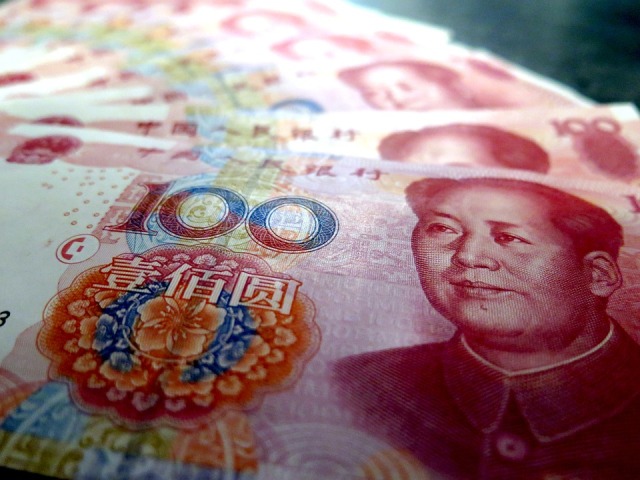WRAPUP 2-China lets yuan slump past 7 per dollar for first time in over decade as trade war escalates

- Country:
- China
China on Monday let the yuan tumble beyond the key 7-per-dollar level for the first time in more than a decade, in a sign Beijing might be willing to tolerate further currency weakness in the face of an escalating trade row with the United States.
The sharp 1.4% drop in the yuan came after the People's Bank of China (PBOC) set the daily mid-point of the currency's trading band at 6.9225 per dollar, its weakest level since December 2018. "Today's fixing was the last line in the sand," said Ken Cheung, senior Asian FX strategist at Mizuho Bank in Hong Kong.
"The PBOC has fully given the green light to yuan depreciation" The shakeout in the yuan comes days after U.S. President Donald Trump stunned financial markets by vowing to impose 10% tariffs on the remaining $300 billion of Chinese imports from Sept. 1, abruptly breaking a brief month-long ceasefire in the bruising trade war.
After opening the onshore session at 6.9999 per dollar, the yuan had weakened to 7.0266 per dollar by 0351 GMT, down 1.2% on the day after earlier losing as much as 1.4% of its value. Monday marked the first time the yuan had breached the 7-per-dollar level since May 9, 2008. With the escalating trade war giving Beijing fewer reasons to maintain yuan stability, analysts said they expect the currency to continue to weaken.
"In the short-term, the yuan's strength would be largely determined by the domestic economy. If third-quarter economic growth stabilizes, the yuan could stabilize around 7.2 or 7.3 level," Zhang Yi, chief economist at Zhonghai Shengrong Capital Management in Beijing. Capital Economics senior China economist Julian Evans-Pritchard said the PBOC had probably been holding back against allowing a weaker yuan to avoid derailing trade negotiations with the United States.
"The fact that they have now stopped defending 7.00 against the dollar suggests that they have all but abandoned hopes for a trade deal with the U.S.," he said. The PBOC gave few clues about its intentions. In a statement on Monday, the central bank linked the yuan's weakness to the fallout from the trade war, but said it would not change its currency policy and that two-way fluctuations in the yuan's value are normal.
"Under the influence of factors including unilateralism, protectionist trade measures, and expectations of tariffs against China, the yuan has depreciated against the dollar today, breaking through 7 yuan per dollar," the PBOC said. The yuan's weakness was not confined to the onshore market. The offshore yuan also slumped, hitting a record low against the dollar of 7.1094 before rebounding to 7.0784 around 0358 GMT.
YUAN AS TRADE WEAPON?
The flare-up in trade tensions has renewed global financial market concerns over how much China will allow the yuan to weaken to offset heavier pressure on its exporters.
"With additional tariffs on the way, the PBOC is likely to come up with more easing to support growth," said Frances Cheung, head of a macro strategy, Asia, at Westpac in Singapore. Analysts have previously said that authorities will keep depreciation in check due to concerns about potential capital outflows.
Despite slowing economic growth over the past year amid the intensifying trade war, China has not seen a rush of capital flight, thanks to capital controls put in place during the last economic downturn and growing foreign inflows into Chinese stocks and bonds. In 2015, China stunned global financial markets by devaluing the yuan 2% as its economy slowed. It burned through $1 trillion in foreign exchange reserves to steady it.
But Monday's slump past the 7-per-dollar level could further intensify the economic conflict between the United States and China. Trump has long been critical of Beijing for manipulating its currency to gain a trade advantage, and further yuan weakness could draw Washington's wrath. Capital Economics' Evans-Pritchard believes Trump is likely to be angered by the PBOC's explicit linking of Monday's yuan weakness to the renewed tariff threat.
Shares were also hit hard, with a sharp decline in Hong Kong equities weighing on the overall market, Gerry Alfonso, director at Shenwan Hongyuan Securities Co, said in an emailed comment. Hong Kong's Hang Seng index was 2.89% lower at midday as the city faced major disruptions, with a general strike paralyzing parts of the Asian financial center.
Alex Wang, Hong Kong-based analyst with Ample Finance Group, said worries over Hong Kong's economy, which slowed more than expected in the second quarter, have been exacerbated by ongoing protests, with sectors including retail and tourism bearing the brunt of the impact. The benchmark Shanghai Composite Index fell 0.81% and the blue-chip CSI300 index lost 1.03%.
Highlighting the widening impact of the trade tensions, agricultural commodities prices surged after a report that China had asked state-owned firms to half imports of U.S. agricultural products. China soymeal futures rose more than 2% and rapeseed meal futures jumped as much as 3%. But China's Dalian iron ore futures dropped, hitting their weakest level since July, while London copper hit its lowest in more than two years as investors worried that the trade war would hit global growth and metals demand.
Also Read: HK police fire teargas as China says it will not 'sit idly by'
(This story has not been edited by Devdiscourse staff and is auto-generated from a syndicated feed.)
ALSO READ
500 foreign maids in Singapore duped in 2023, says govt
Singapore plans to build a pool of 100 nuclear experts
GLOBAL MARKETS-Nikkei leads Asia higher as yen skids; commodities in demand
GLOBAL MARKETS-Nikkei leads Asia higher as yen slips; commodities on a roll
Southeast Asian countries consider ways to boost 'green financing' as region chokes on smog










